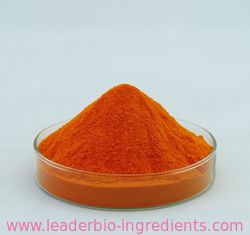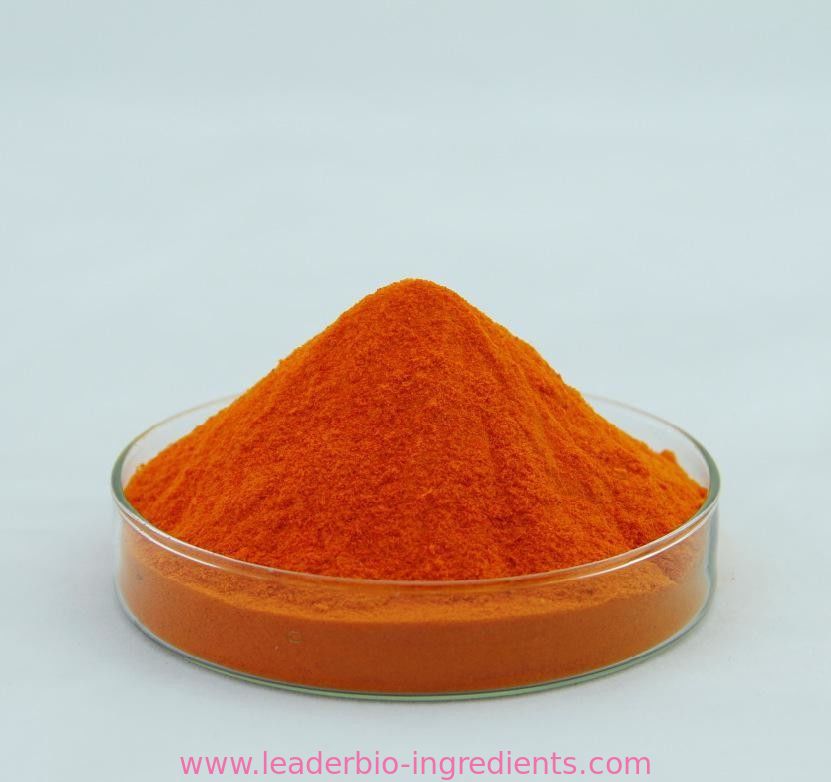
China Northwest Factory Manufacturer Beta-Carotene Cas 7235-40-7 For stock delivery
-
Purity99.9%
-
UseHealth Care
-
OriginChina
-
Package1KG/Tin 25KG/Drum*Carton
-
ManufacturerXI'AN LEADER BIOCHEMICAL ENGINEERING CO.,LTD
-
Place of OriginCHINA
-
Brand NameLeader
-
CertificationISO,GMP,SGS,HALA,KOSER,HACCP
-
Model NumberLD
-
Minimum Order Quantity25KGS
-
PriceNegotiate
-
Packaging Details25KG/Drum
-
Delivery Time2-3 working days
-
Payment TermsWestern Union, MoneyGram, T/T, L/C
-
Supply Ability10MTS/Month
China Northwest Factory Manufacturer Beta-Carotene Cas 7235-40-7 For stock delivery
| beta-Carotene Usage And Synthesis |
| Description | b-Carotene is applied as a food coloring additive, as provitamin A in food and feed, in multivitamin products, as an antioxidant, and as a colorant for cosmetics. In the literature, a number of microorganisms are described that are capable of accumulating b-carotene up to relatively high levels, for example, the fungi B. trispora, Phycomyces blakesleanus, the yeast Rhodotorula glutinis, and the above-mentioned alga D. salina. Production processes were developed with mutants of B. trispora in the former Soviet Union (cf. Sect. 2.3) and for D. salina. Among the b-carotene–producing algae, D. salina is currently the best-known and most efficient producer: D. salina cells are able to synthesize b-carotene in levels a thousand times higher than those of carrots. Dunaliella is also able to synthesize a-carotene, violaxanthin, neoxanthin, zeaxanthin, and lutein. The unicellular green alga D. salina is grown in open ponds without (hardly any) process control. It was shown that the highest production levels were obtained with high light intensities, nitrogen limitation, and stress-inducing temperatures. This has resulted in b-carotene levels up to 12 % of the dry mass. The production facilities are located in places where optimum conditions are found, namely in Australia, Israel, and in the United States; these places benefit from a lot of sunshine, little cloudiness, the availability of saline water, and high average temperatures. |
| Chemical Properties | solid |
| Originator | Carotaben,Hermal,W. Germany,1975 |
| Occurrence | Beta-carotene is available naturally in fruits and vegetables. Synthetically, it may be manufactured from fungi or algae. |
| Uses | Beta-Carotene is a colorant that is a carotenoid producing a yellow to orange hue. it has good tinctorial strength, fair light stability, poor oxidation stability, and good ph stability. it is insoluble in water but is available in water-dispersible, oil-dispersible, and oil- soluble forms. it has vitamin a activity. it has a natural resistance to ascorbic acid reduction in beverages and thus is used in orange- colored liquid products. it is used in margarine, oils, cheese, and puddings at levels required to produce the desired color. related colorants are canthaxanthin and beta-apo-8-carotenal. |
| Uses | antioxidant; provitamin A |
| Uses | Yellow coloring agent for foods. |
| Uses | Most important of the provitamins A. Widely distributed in the plant and animal kingdom. In plants it occurs almost always togr with chlorophyll. Vitamin A precursor. Ultraviolet screen |
| Uses | beta-carotene is a known anti-oxidant. It has demonstrated photo protection properties particularly when taken internally. It is also used as a yellow-orange color additive. Beta-carotene is a caratinoid and a precursor to vitamin A. It is beneficial for dry and flaking skin. naturally occurring in fruits and vegetables that contain orange-yellow pigment, such as apricots, carrots, mangoes, and oranges, beta-carotene can also be synthetically manufactured. |
| Definition | ChEBI: A cyclic carotene obtained by dimerisation of all-trans-retinol. A strongly-coloured red-orange pigment abundant in plants and fruit and the most active and important provitamin A carotenoid. |
| Manufacturing Process | 3.6 g (0.023 mol) of 3,8-dimethyl-3,5,7-decatrien-1,9-diyne were dissolved in 50 ml of absolute r, and to the solution was added 0.05 mol of real phenyl-lithium solution. The mixture was refluxed for 30 minutes. Then a solution of 11 g (0.05 mol) of 4-(2,6,6-trimethyl-1-cyclohexen-1-yl)-2-methyl- 2-buten-1-al in 100 ml of r was added dropwise, and the reaction mixture was boiled for 2 hours. The reaction mixture was then hydrolyzed with aqueous ammonium acetate solution, and the real layer was separated, dried and concentrated. The residue, i.e., 1,18-di(2,6,6-trimethyl-1- cyclohexen-1-yl)-3,7,12,16-tetramethyl-4,15-dihydroxy-2,7,9,11,16- octadecapentaen-5,13-diyne, was a resinous product (having 1.9 active hydrogen atoms and absorption maxima in the ultraviolet spectrum at 326 and 341 nm) which was used for the next step without any further purification. The resin was dissolved in 200 ml of methylene chloride, 10 ml of glacial acetic acid were added to the solution, and the mixture was cooled to - 40°C in a carbon dioxide atmosphere, while stirring. Then, 9 ml of aqueous hydrobromic acid (60%) were added in one portion, the mixture was stirred at -35°C for 1.5 minutes, and subsequently 200 ml of ice water were run into the mixture. After further stirring the mixture for 2 hours at 0°C, the methylene chloride layer was separated, washed with water and sodium bicarbonate solution, dried with Na2SO4 andconcentrated in vacuo. The residue, i.e., 11,12-11',12'-bisdehydro-betta-carotene, was a tough resin or a foamy solid (having no active hydrogen atoms and possessing absorption maxima in the ultraviolet spectrum at 334 and 408 nm). This product can be purified by chromatography. The crude product can also be used for the next step without any preliminary purification. 11.4 g of 11,12-11',12'-bisdehydro-β-carotene were dissolved in 100 ml of petroleum r (boiling range 80° to100°C), and the solution was hydrogenated under normal conditions after the addition of 0.5 ml of quinoline and 5 g of a lead-poisoned palladium catalyst. After the calculated amount of hydrogen had been absorbed, the catalyst was removed by filtration and the filtrate was extracted with dilute sulfuric acid to remove the quinoline. By concentrating the solution in the usual manner there was obtained 11,12- 11',12'-di-cis-carotene. The product was purified by recrystallization from benzene-alcohol. The purified product melts at 154°C; absorption maxima in the ultraviolet spectrum at 276, 334, 338, 401 and 405 nm. The isomerization was effected by heating the product for 10 hours at 90 to 100°C in high-boiling petroleum r in a carbon dioxide atmosphere. The resulting and carotene melted at 180°C; ultraviolet absorption maxima at 452 and 480 nm. Preparation of the intermediates for the above chemical synthesis are also described in US. Patent 2,917,539. The other patents cited below describe a fermentation route. US Patent 2,848,508 describes preparation from carrots. |
| Brand name | BetaVit (BASF); Lucaratin (BASF); Solatene (Hoffmann-LaRoche). |
| Therapeutic Function | Vitamin A precursor, Sunscreen agent |
| Safety Profile | When heated to decomposition it emits acrid smoke and irritating fumes. |
| Purification Methods | It forms purple prisms when crystallised from *C6H6/MeOH and red rhombs from pet r. Its solubility in hexane is 0.1% at 0o. It is oxygen sensitive and should be stored under N2 at -20o in the dark. It gives a deep blue colour with λmax at 590nm when mixed with SbCl3 in CHCl3. UV: (*C6H6) 429infl, max at 454 and 484nm. The principal peak at 454nm has 1cm 1% 2000. [Synthesis: Surmatis & Ofner J Org Chem 26 1171 1961; Milas et al. J Am Chem Soc 72 4844 1950.] β-Carotene is also purified by column chromatography (Al2O3 activity I-II). It is dissolved in pet r/*C6H6 (10:1), applied to the column and eluted with pet r/EtOH; the desired fraction is evaporated and the residue is recrystallised from *C6H6/MeOH (violet-red plates). [UV: Inhoffen et al. Justus Liebigs Ann Chem 570 54, 68 1950; Review: Fleming Selected Organic Synthesis (J Wiley, Lond) pp. 70-74 1973.] Alternatively it can be purified by chromatography on a magnesia column, thin layer of Kieselguhr or magnesia. Crystallise it from CS2/MeOH, Et2O/pet r, /pet r or toluene/MeOH. Store it in the dark, under an inert atmosphere, at -20o. Recrystallise it also from 1:1 EtOH/CHCl3. [Bobrowski & Das J Phys Chem 89 5079 1985, Johnston & Scaiano J Am Chem Soc 1 0 8 2349 1986, Strain J Biol Chem 105 523 1934, Meth Biochem Anal 4 1 1957, Beilstein 5 II 638, 5 III 2453, 5 IV 2617.] |
